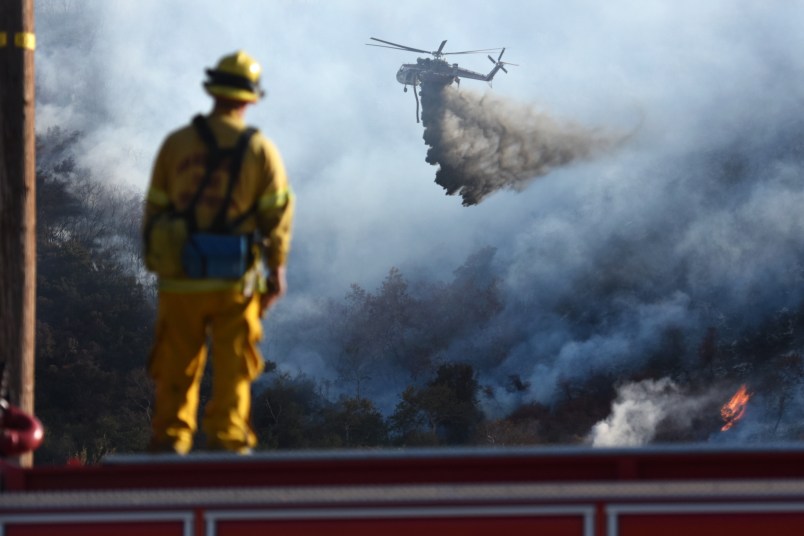SAN BERNARDINO, Calif. (AP) — Firefighters were on the offensive Friday as they worked to expand significant gains against a huge wildfire that chased thousands of people from their homes in Southern California.
“We’ve got the ball, we’re on the move,” fire information officer Bob Poole said.
The fire has scorched nearly 58 square miles and was 26 percent contained as it entered its fourth day in mountains and desert 60 miles east of Los Angeles.
Poole said it was “spectacular” to make progress so quickly against such a big fire that had firefighters on the defensive for the first 1½ days.
Plans were underway to demobilize some of the nearly 1,600 firefighters.
“Crews really buttoned up some areas. But the possibility is still there for explosive growth,” said Brad Pitassi, another fire spokesman.
One area of concern was southeast of the ski town of Wrightwood, where old-growth brush and trees haven’t burned in 70 years, fire behavior analyst Brendan Ripley said.
Elsewhere, the fire’s growth was limited because flames had reduced the land to a moonscape.
“The fire burned so intensely that there’s no fuels left for it to move again,” Pitassi said.
Some 82,000 residents were under evacuation orders at the height of the fire. A small number of evacuees have been allowed to return home, but Pitassi could not say when all the evacuations would be lifted.
Long-awaited damage assessments were expected to be released later Friday, he said.
Among those waiting to return was Lisa Gregory, who didn’t know whether her house was still standing.
The uncertainty “is an awful feeling,” she said Thursday as she lounged in a lawn chair under a tree outside an evacuation center.
Meanwhile, a new fire broke out in rural Santa Barbara County, quickly surging to about 600 acres and prompting the evacuation of a pair of campgrounds.
In the southern Sierra Nevada, another blaze feeding on dense timber in Sequoia National Forest exploded to nearly 15 square miles. Tiny hamlets in Kern and Tulare counties were evacuated.
During five years of drought, California’s wildlands have seen a continuous streak of destructive and sometimes deadly fires. No deaths have been reported in the latest fire, but crews assessing property damage were using cadaver dogs during searches.
The dry vegetation is like firewood, said fire information officer Sean Collins.
“It burns that much quicker, that much hotter. The rate of travel is extremely fast,” he said.
Wildfires across the country in recent years have grown more ferocious and expensive to fight.
Last year’s fire season set a record with more than 15,625 square miles of land charred. It was also the costliest on record with $2.1 billion spent to fight fires from Alaska to Florida.
Experts have blamed several factors including rising temperatures that more quickly dry out forests and vegetation. Decades of aggressively knocking down small fires also have led to the buildup of flammable fuel. On top of that, more people are moving into fire-prone regions, complicating firefighting efforts.
The Southern California fire unleashed its initial fury on a semi-rural landscape dotted with small ranches and homes in Cajon Pass and on the edge of the Mojave Desert before climbing the mountains.
In mountains north of San Francisco, a 6-square-mile blaze was 55 percent contained after destroying at least 268 structures, including 175 homes and eight businesses, in the working-class community of Lower Lake.
The equipment manager, or “armorer,” of the U.S. Olympic fencing team, was among those who lost their homes. Matthew Porter was in Rio with the medal-winning team when the house burned.
___
Associated Press writers John Antczak, Amanda Lee Myers and Robert Jablon in Los Angeles and Kristin Bender and Olga Rodriguez in San Francisco contributed to this report.
Copyright 2016 The Associated Press. All rights reserved. This material may not be published, broadcast, rewritten or redistributed.



